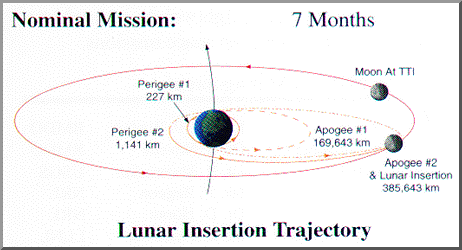I have been working on a study of the Clementine program, a lunar orbiter that flew in 1994. Here is the abstract for this study. I would welcome any thoughts about it.
In the early 1990s, just as the Cold War was coming to an end the Department of Defense’s (DoD) Ballistic Missile Defense Organization (BMDO) undertook a space science mission, drawing NASA into it to oversee the science component. The Clementine space probe to the Moon was supposed to test sensors and spacecraft components under extended exposure to the space environment and to make scientific observations of the Moon. The observations included imaging at various wavelengths, including ultraviolet and infrared, laser ranging altimetry, and charged particle measurements.
Operated on a shoestring budget, the Clementine spacecraft was launched on January 25, 1994, from the West Coast launch complex at Vandenberg Air Force Base, and achieved lunar insertion on February 21. Lunar mapping took approximately two months, but as the mission was beginning a new phase in May 1994, the spacecraft malfunctioned. In spite of this, Clementine mapped more than 90 percent of the lunar surface. The late 1996 revelation from scientists that data returned by Clementine indicated that ice existed from an asteroid crash at the Moon’s South Pole re-energized lunar science.
More importantly, this project provides a recent case study in longstanding difficult history of the roles and missions of space science activities in the United States. It points up the often testy relationship between the military space world, which had abundant resources but not the mandate for space science, and the civil space community, which had the mandate for space science but not the resources to pursue it aggressively. Their cooperation in this project might be viewed as a success story, but at other levels it illuminates bureaucratic non-cooperation, inter-organizational rivalry, and disputes over authority for these efforts. It also set in train a succession of post-Cold War alterations to relationships that had existed for nearly half a century. This paper will trace these alterations through the case study of the Clementine project.
Finally, this is a story of personalities, especially Stuart D. Nozette, Clementine’s Deputy Project Manager who talked the Pentagon into spending $75 mission as well as use its sensors and other equipment designed to track missiles and test “Star Wars” capabilities to prospect for water on the Moon. It also involves such figures as George Abbey and Mark Albrecht, serving as President Bush’s National Space Council, who pressed NASA to support the BMDO initiative, and NASA administrator Richard Truly and NASA associate administrator for space science Lennard Fisk who were wary of the incursion of the DoD into NASA’s science program.




$75 mission ??? million ???
LikeLike
oops, you’re right. It should be million. I just made this change in the text. Thanks for correcting this.
LikeLike
Thanks much. I appreciate the comment.
LikeLike
Have we seen a truly successful joint venture between the military and NASA/NOAA? This partnership seems to have crippled our weather satellite program. PBS just had a good story on the looming crisis with our earth observation satellites at http://www.pbs.org/wgbh/nova/next/space/going-blind-the-coming-satellite-crisis/. I know the Shuttle was compromised to get USAF support during it’s development. So can you have a joint-program that actually is functional, doesn’t waste money & resources and in the end gets the intended job done in a timely manner? If memory serves there was a lot of cross pollination during Mercury and Gemini for use of the Atlas and Titan boosters and the Redstone was a ABMA legacy booster. I don’t recall a successful joint satellite program but I admit I am more familiar with our manned space program versus robotic programs.
LikeLike
Great observations. Thanks.
LikeLike
Roger,
I was involved in Clementine from the beginning. This could be a very interesting study. Please contact me and let’s talk about it (spudis@lpi.usra.edu)
Best,
Paul
LikeLike
Paul, I would love to talk to you abiut this. I’ll get with you soon
LikeLike
I am a researcher and my theory is that the Clementine mission never was meant to be a joint venture between the US DoD and NASA. The military did not have a deep space network but NASA did. In my view the real reason for this mission is a different one and one that never would have been dislosed.
LikeLike